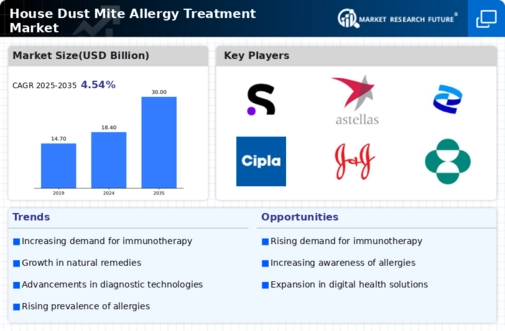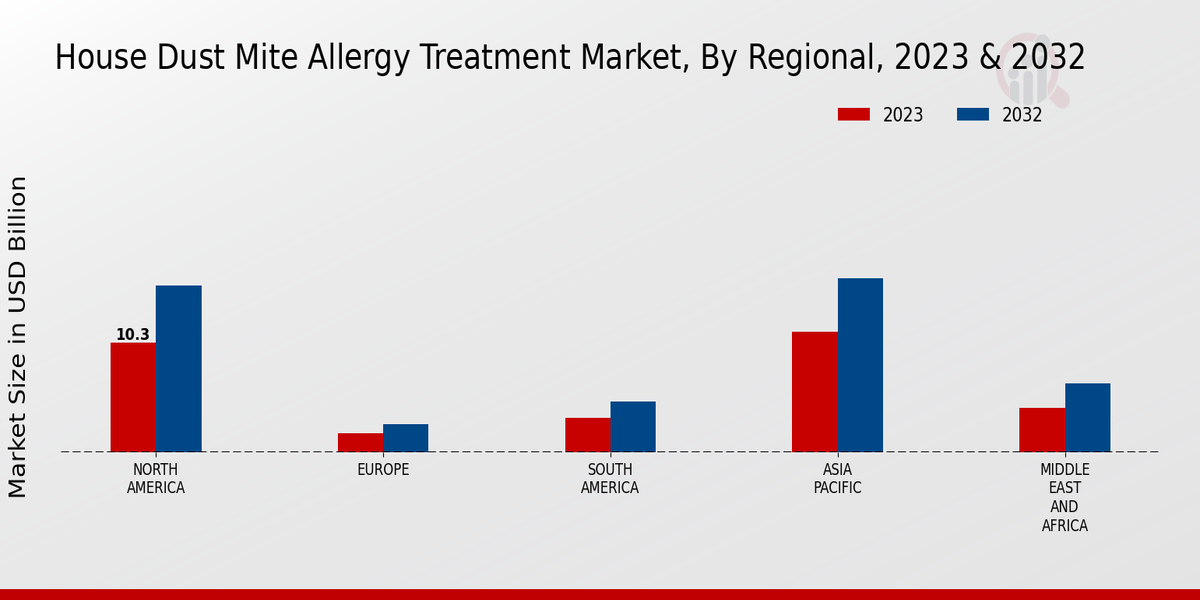Market Growth Projections
The Global House Dust Mite Allergy Treatment Market Industry is projected to experience substantial growth over the coming years. With a market value anticipated to reach 18.4 USD Billion in 2024 and further expand to 30.0 USD Billion by 2035, the industry is on a promising trajectory. The compound annual growth rate (CAGR) of 4.54% from 2025 to 2035 indicates a robust demand for allergy treatments. This growth is likely driven by various factors, including increased awareness, advancements in treatment options, and supportive regulatory environments.
Rising Prevalence of Allergies
The increasing incidence of allergies globally is a notable driver for the Global House Dust Mite Allergy Treatment Market Industry. According to health statistics, approximately 20% of the global population suffers from allergic conditions, with house dust mites being a primary allergen. This growing prevalence is likely to escalate the demand for effective treatments, contributing to the market's expansion. As awareness of allergy management rises, the market is projected to reach 18.4 USD Billion in 2024, indicating a robust growth trajectory. The need for innovative solutions to address this widespread issue will further stimulate market dynamics.
Advancements in Treatment Options
Innovations in treatment methodologies are significantly influencing the Global House Dust Mite Allergy Treatment Market Industry. Recent developments include the introduction of sublingual immunotherapy and monoclonal antibodies, which offer targeted relief for allergy sufferers. These advancements not only enhance patient compliance but also improve treatment efficacy. As a result, the market is expected to experience a compound annual growth rate (CAGR) of 4.54% from 2025 to 2035. The continuous evolution of treatment options is likely to attract investments and foster competition among key players, thereby driving market growth.
Increased Awareness and Education
Heightened awareness regarding house dust mite allergies is a crucial factor propelling the Global House Dust Mite Allergy Treatment Market Industry. Educational initiatives by health organizations and advocacy groups have led to greater public understanding of allergy triggers and management strategies. This increased awareness is likely to result in more individuals seeking treatment, thereby expanding the market. As the global population becomes more informed about the implications of untreated allergies, the demand for effective interventions is expected to rise, contributing to the market's projected growth to 30.0 USD Billion by 2035.
Regulatory Support and Guidelines
Supportive regulatory frameworks and guidelines are fostering growth within the Global House Dust Mite Allergy Treatment Market Industry. Governments and health authorities are increasingly recognizing the importance of allergy management, leading to the establishment of policies that promote research and development in this field. Such initiatives not only enhance the availability of treatment options but also encourage manufacturers to innovate. As regulatory support strengthens, the market is poised for sustained growth, with a projected increase in value as new therapies and products enter the market.
Growing Urbanization and Lifestyle Changes
Urbanization and changing lifestyles are contributing to the expansion of the Global House Dust Mite Allergy Treatment Market Industry. As more individuals reside in urban environments, exposure to allergens such as dust mites tends to increase due to higher population density and indoor living conditions. Furthermore, lifestyle changes, including the use of synthetic materials in homes, can exacerbate allergy symptoms. This trend is likely to drive demand for effective treatments, as urban populations seek solutions to manage their health. The market's growth trajectory reflects these evolving dynamics, indicating a need for targeted interventions.


















